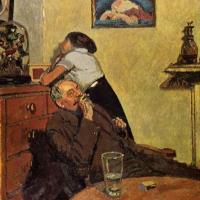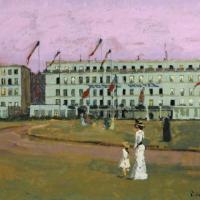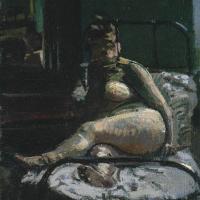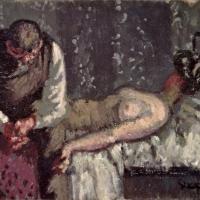Walter Sickert
Walter Sickert
Walter Sickert (1860-1942)
Walter Richard Sickert (31 May 1860 – 22 January 1942) was a British painter and printmaker who was a member of the Camden Town Group in London. He was an important influence on distinctively British styles of avant-garde art in the 20th century.
Sickert was a cosmopolitan and eccentric who often favoured ordinary people and urban scenes as his subjects. His work also included portraits of well-known personalities and images derived from press photographs. He is considered a prominent figure in the transition from Impressionism to Modernism.
Sickert was born in Munich, Germany, on 31 May 1860, the eldest son of Oswald Sickert, a Danish-German artist, and his wife, Eleanor Louisa Henry, who was an illegitimate daughter of the British astronomer Richard Sheepshanks. In 1883 he travelled to Paris and met Edgar Degas, whose use of pictorial space and emphasis on drawing would have a powerful effect on Sickert's work. He developed a personal version of Impressionism, favouring sombre colouration. Following Degas' advice, Sickert painted in the studio, working from drawings and memory as an escape from "the tyranny of nature".
Sickert's fascination with urban culture accounted for his acquisition of studios in working-class sections of London, first in Cumberland Market in the 1890s, then in Camden Town in 1905. The latter location provided an event that would secure Sickert's prominence in the realist movement in Britain.
After the death of his second wife in 1920, Sickert relocated to Dieppe, where he painted scenes of casinos and café life until his return to London in 1922. In 1924, he was elected an Associate of the Royal Academy (ARA).
In 1926 he suffered an illness, thought to have been a minor stroke. In 1927, he abandoned his first name in favour of his middle name, and thereafter chose to be known as Richard Sickert. His style and subject matter also changed: Sickert stopped drawing, and instead painted from snapshots usually taken by his third wife, Thérèse Lessore, or from news photographs. The photographs were squared up for enlargement and transferred to canvas, with their pencil grids plainly visible in the finished paintings.
Sickert painted an informal portrait of Winston Churchill in about 1927. Churchill's wife Clementine introduced him to Sickert, who had been a friend of her family. The two men got along so well that Churchill, whose hobby was painting, wrote to his wife that "He is really giving me a new lease of life as a painter."
Sickert tutored and mentored students of the East London Group, and exhibited alongside them at The Lefevre Gallery in November 1929.
Sickert made his last etching in 1929.
Sickert became a Royal Academician (RA) in March 1934 but resigned from the Academy on 9 May 1935 in protest against the president's refusal to support the preservation of Jacob Epstein's sculptural reliefs on the British Medical Association building in the Strand. In the last decade of his life, he depended increasingly on assistants, especially his wife, for the execution of his paintings.
Sickert died in Bath, Somerset in 1942, at the age of 81. He had spent much time in the city in his later years, and many of his paintings depict Bath's varied street scenes. He had been married three times: from 1885 until their divorce in 1899 to Ellen Cobden, a daughter of Richard Cobden; from 1911 until her death in 1920 to Christine Angus; and from 1926 until his death to the painter Thérèse Lessore.
For his earliest paintings, Sickert followed Whistler's practice of rapid, wet-in-wet execution using very fluid paint. He subsequently adopted a more deliberate procedure of painting pictures in multiple stages, and "attached a great deal of importance to what he called the 'cooking' side of painting". He preferred to paint not from nature but from drawings or, after the mid-1920s, from photographs or from popular prints by Victorian illustrators. After transferring the design to canvas by the use of a grid, Sickert made a rapid underpainting using two colours, which was allowed to dry thoroughly before the final colours were applied. He experimented tirelessly with the details of his method, always with the goal, according to his biographer Wendy Baron, of "paint[ing] quickly, in about two sittings, with the maximum economy and minimum of fuss".
Sickert tended to paint his subjects in series. He is identified particularly with domestic interior scenes, scenes of Venice, music hall and theatre scenes, and portraits. He painted very few still lifes. For his music hall subjects, Sickert often chose complex and ambiguous points of view, so that the spatial relationship between the audience, performer and orchestra becomes confused, as figures gesture into space and others are reflected in mirrors. The isolated rhetorical gestures of singers and actors seem to reach out to no-one in particular, and audience members are portrayed stretching and peering to see things that lie beyond the visible space. This theme of confused or failed communication between people appears frequently in his art. By emphasising the patterns of wallpaper and architectural decorations, Sickert created abstract decorative arabesques and flattened the three-dimensional space. His music hall pictures, like Degas' paintings of dancers and café-concert entertainers, connect the artificiality of art itself to the conventions of theatrical performance and painted backdrops.
Sickert often professed his distaste for what he termed the "beastly" character of thickly textured paint. In an article he wrote for The Fortnightly Review in 1911, he described his reaction to the paintings of Van Gogh: "I execrate his treatment of the instrument I love, these strips of metallic paint that catch the light like so many dyed straws ... my teeth are set on edge". In response to Alfred Wolmark's work he declared that "thick oil-paint is the most undecorative matter in the world".
Nonetheless, Sickert's paintings of the Camden Town Murder series of c. 1906–1909 were painted in heavy impasto and narrow tonal range, as were numerous other obese nudes in the pre-World War I period in which the fleshiness of the figures is connected to the thickness of the paint—a device that was later adapted by Lucian Freud. The influence of these paintings on successive generations of British artists has been noted in the works of Freud, David Bomberg, Francis Bacon, Frank Auerbach, Howard Hodgkin, and Leon Kossoff.
In the 1910s and 1920s, the dark, gloomy tones of his early paintings gradually brightened, and Sickert juxtaposed unexpected tones with a new boldness in works such as Brighton Pierrots (1915) and Portrait of Victor Lecourt (1921–24). His several self-portraits usually displayed an element of role-playing consistent with his early career as an actor: Lazarus Breaks his Fast (c. 1927) and The Domestic Bully (c. 1935–38) are examples. Sickert's late works display his preference for thinly scrubbed veils of paint, described by Helen Lessore as "a cool colour rapidly brushed over a warm underpainting (or vice versa) on a coarse canvas and in a restricted range allow[ing] the undercoat to 'grin through'".
Sickert insisted on the importance of subject matter in art, saying that "all the greater draughtsmen tell a story", but treated his subjects in a detached manner. According to the painter Frank Auerbach, "Sickert's detachment became increasingly evident in his uninhibited procedures. He made obvious his frequent reliance on snapshots and press photographs, he copied, used and took over the work of other, dead, artists and made extensive use, also, of the services of his assistants who played a large and increasing part in the production of his work."






